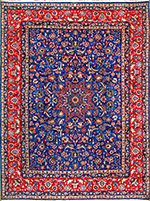Textiles Studies

Textile Research Works
Date of this Version
2015
Document Type
Article
Citation
Journal of the American Oriental Society 135.3 (2015), 657-658.
Abstract
From the eleventh century C.E., Islamic geometric patterns have continued to evolve in complexity, contributing a distinct aspect of Islamic art and architecture that covers a broad geographic range and temporal spectrum. The underlying principles of these patterns are brilliantly explained in narrative and visual formats by Eric Broug, a Dutch design professional, self-trained and with an M.A. in the history of Islamic architecture from SOAS in London. Offering both an analytical and practical understanding of the construction of Islamic geometric patterns, this book is an unusual hybrid of scholarship and art, combining the qualities of a coffeetable bibelot and a handbook for aficionados-more than that, however, it rewards careful reading. Understanding geometry requires an engagement in process. Broug has attempted to convey this aspect to the reader through clear analytical diagrams that accompany full-page illustrations of architectural monuments and close-up details of exquisite patterns and complex designs. The appearance of complexity, and the critical role of the circle in construction, are subjects broached in an eloquent manner through which the reader may gain an understanding of the elements of designdivisions of the circle yield intersecting lines, regular polygons, and stars (concave polygons). An appendix provides step-by-step instructions for using a compass and straightedge without reference to measurements or calculations beyond what is offered by these traditional tools, which would have been used to create these patterns in their time.
Included in
Art and Materials Conservation Commons, Art Practice Commons, Fiber, Textile, and Weaving Arts Commons, Indigenous Studies Commons, Museum Studies Commons

